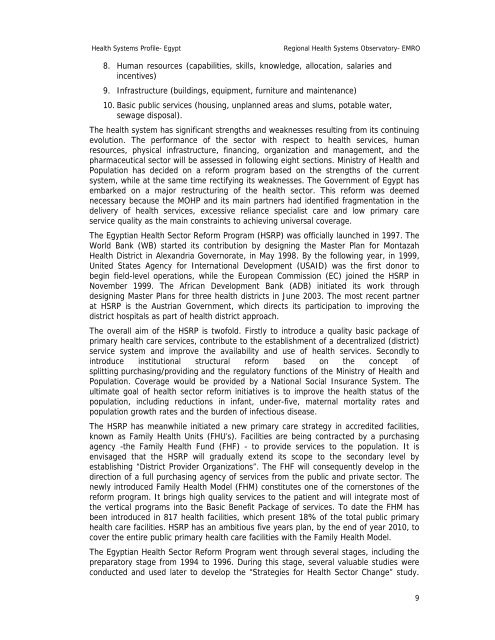Egypt : Complete Profile - What is GIS - World Health Organization
Egypt : Complete Profile - What is GIS - World Health Organization
Egypt : Complete Profile - What is GIS - World Health Organization
You also want an ePaper? Increase the reach of your titles
YUMPU automatically turns print PDFs into web optimized ePapers that Google loves.
<strong>Health</strong> Systems <strong>Profile</strong>- <strong>Egypt</strong> Regional <strong>Health</strong> Systems Observatory- EMRO<br />
8. Human resources (capabilities, skills, knowledge, allocation, salaries and<br />
incentives)<br />
9. Infrastructure (buildings, equipment, furniture and maintenance)<br />
10. Basic public services (housing, unplanned areas and slums, potable water,<br />
sewage d<strong>is</strong>posal).<br />
The health system has significant strengths and weaknesses resulting from its continuing<br />
evolution. The performance of the sector with respect to health services, human<br />
resources, physical infrastructure, financing, organization and management, and the<br />
pharmaceutical sector will be assessed in following eight sections. Min<strong>is</strong>try of <strong>Health</strong> and<br />
Population has decided on a reform program based on the strengths of the current<br />
system, while at the same time rectifying its weaknesses. The Government of <strong>Egypt</strong> has<br />
embarked on a major restructuring of the health sector. Th<strong>is</strong> reform was deemed<br />
necessary because the MOHP and its main partners had identified fragmentation in the<br />
delivery of health services, excessive reliance special<strong>is</strong>t care and low primary care<br />
service quality as the main constraints to achieving universal coverage.<br />
The <strong>Egypt</strong>ian <strong>Health</strong> Sector Reform Program (HSRP) was officially launched in 1997. The<br />
<strong>World</strong> Bank (WB) started its contribution by designing the Master Plan for Montazah<br />
<strong>Health</strong> D<strong>is</strong>trict in Alexandria Governorate, in May 1998. By the following year, in 1999,<br />
United States Agency for International Development (USAID) was the first donor to<br />
begin field-level operations, while the European Comm<strong>is</strong>sion (EC) joined the HSRP in<br />
November 1999. The African Development Bank (ADB) initiated its work through<br />
designing Master Plans for three health d<strong>is</strong>tricts in June 2003. The most recent partner<br />
at HSRP <strong>is</strong> the Austrian Government, which directs its participation to improving the<br />
d<strong>is</strong>trict hospitals as part of health d<strong>is</strong>trict approach.<br />
The overall aim of the HSRP <strong>is</strong> twofold. Firstly to introduce a quality basic package of<br />
primary health care services, contribute to the establ<strong>is</strong>hment of a decentralized (d<strong>is</strong>trict)<br />
service system and improve the availability and use of health services. Secondly to<br />
introduce institutional structural reform based on the concept of<br />
splitting purchasing/providing and the regulatory functions of the Min<strong>is</strong>try of <strong>Health</strong> and<br />
Population. Coverage would be provided by a National Social Insurance System. The<br />
ultimate goal of health sector reform initiatives <strong>is</strong> to improve the health status of the<br />
population, including reductions in infant, under-five, maternal mortality rates and<br />
population growth rates and the burden of infectious d<strong>is</strong>ease.<br />
The HSRP has meanwhile initiated a new primary care strategy in accredited facilities,<br />
known as Family <strong>Health</strong> Units (FHU’s). Facilities are being contracted by a purchasing<br />
agency -the Family <strong>Health</strong> Fund (FHF) - to provide services to the population. It <strong>is</strong><br />
env<strong>is</strong>aged that the HSRP will gradually extend its scope to the secondary level by<br />
establ<strong>is</strong>hing “D<strong>is</strong>trict Provider <strong>Organization</strong>s”. The FHF will consequently develop in the<br />
direction of a full purchasing agency of services from the public and private sector. The<br />
newly introduced Family <strong>Health</strong> Model (FHM) constitutes one of the cornerstones of the<br />
reform program. It brings high quality services to the patient and will integrate most of<br />
the vertical programs into the Basic Benefit Package of services. To date the FHM has<br />
been introduced in 817 health facilities, which present 18% of the total public primary<br />
health care facilities. HSRP has an ambitious five years plan, by the end of year 2010, to<br />
cover the entire public primary health care facilities with the Family <strong>Health</strong> Model.<br />
The <strong>Egypt</strong>ian <strong>Health</strong> Sector Reform Program went through several stages, including the<br />
preparatory stage from 1994 to 1996. During th<strong>is</strong> stage, several valuable studies were<br />
conducted and used later to develop the “Strategies for <strong>Health</strong> Sector Change” study.<br />
9

















